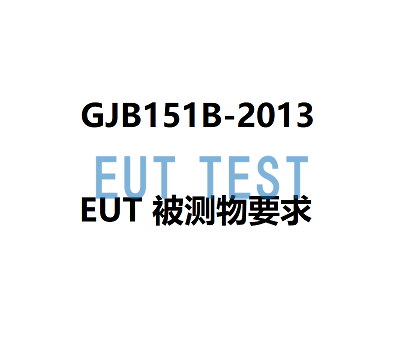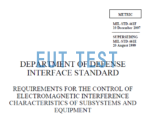EUT is in the EMC industry is the English abbreviation for the object to be measured / to be measured, this paper focuses on the GJB151B-2013 EUT requirements for what aspects of the EUT, including the layout requirements, EUT interconnection cable laying, working conditions and other requirements.
EUT arrangement requirements:
The hardware and software of the EUT should be representative and in operating condition for typical functions. The software may be supplemented with auxiliary programs to provide the capability for performance evaluation.
Any interim measures taken for the EUT during the test (e.g., adding filters, copper foil on the outside of the enclosure, wave guards or magnetic loops for cables, etc.) should be documented in the EMC test report.
Lap requirements for EUT
The equipment enclosure may only be lapped to the mounting base etc. or lapped to an earthed flat plate if this is specified in the EUT design and installation instructions. The lap strip shall correspond to the provisions in the installation instructions.
Mounting bracket with shock absorber
If the EUT is mounted using a mounting bracket with a shock absorber, the EUT should be secured to that mounting bracket. The lap bar supplied with the mounting bracket should be lapped to the grounding plate. When the mounting bracket does not have a lap bar, the lap bar should not be used.
safely
When the EUT has an external terminal, connector pin or equipment grounding conductor connected to a safety ground and is used in a physical installation, it shall be connected to a grounding plate. Its arrangement and length shall meet the requirements of 4.3 .8.6. 1.
EUT Orientation
The surface on which the EUT produces the greatest radiated emission or the surface that is most responsive to the radiated signal should be oriented toward the test antenna.
The bench EUT shall be mounted 10 cm ± 2 cm from the front edge of the grounding plate to provide sufficient space for cable laying in 4.3.8.6.1 and 4.3 .8.6.2.
Construction and laying of EUT cables
summarize
The knot chest and type of cable should simulate actual use. Use shielded cables only when specified in the installation requirements, or use screened money within the cable, but input (main) power lines (including prisoner and ground) should not be screened. Inspect the cable according to the installation requirements to determine whether the cable has been used as specified, e.g. twisted pair, shielded and shielded termination. Cable layout information should be provided in the EMC test report.
Interconnects and interconnecting cables
Individual conductors shall be assembled into cables in the same manner as in the actual installation. The total length of the interconnecting cables in the test configuration shall be the same as the length of the actual platform installation (at least 10m long when the cable ~'s exceed 10m). When cable lengths are not specified, the cables shall be long enough to meet the following conditions: at least the first 2m of each interconnecting cable terminated with the EUT (unless the cable length is shorter than 2m in the actual installation) shall be parallel to the front boundary defeat line of the configuration, with the remaining length of the cable being placed in a "Z" pattern to the rear of the test configuration. When more than one cable is used in the configuration, the cables are spaced 2cm apart on the outer skin. For benchtop arrangements using a ground plane, the cable closest to the front boundary should be placed 10 cm from the front edge of the ground plane. All cables are supported with a non-conductive support and located 5 cm above the grounding plate, the dielectric constant of the support should be as low as possible.
Input (mains) power cable
Input (mains) power supply means the power supply supplied directly from the system platform. Input (Main) Power Cord means the EUT power cord that is directly connected to the Input (Main) Power Supply.
The 2m long input power cords, including returns, shall be parallel to the front edge of the test configuration in the same manner as the interconnecting cords. Each input power cable, including the return cable, shall be connected to the LISN. Power cables that are part of the interconnecting cable in a practical installation shall be connected to the LISN after being stripped from the harness (or, if the cable is shielded, the power cables under test therein shall be stripped from the cable shield). the power cables shall be connected to the LISN in the shortest distance possible after exposing a length of 2m. the total length of the power cables from the EUT connector to the LISN shall not exceed 2.5m. all power cables are supported by a non-conducting support and located 5cm above the grounding plate. The dielectric constant of the support should be as low as possible. If the power cables are twisted in the actual installation, they should also be twisted before connecting to the LISN.
Electrical and mechanical interfaces
All electrical input and output interfaces shall be connected to actual equipment installed on the platform or to loads that simulate the electrical characteristics (impedance, ground, balance, power, etc.) presented in the actual installation. An input signal shall be applied to the interface in question to operate all circuits of the EUT. EUTs with mechanical outputs shall be loaded. When variable electrical or mechanical loads are present in the actual installation, then it shall be tested under expected worst case conditions. When active electrical loads (e.g., test equipment) are used, measures shall be taken to ensure that the active loads both meet the requirements of 4.3.4 and do not respond to the sensitivity test signal. For EUTs with removable antennas, the antenna port is terminated with a shielded matching load.
EUT operating status
summarize
For emission tests. The EUT shall be operated in the state of maximum emission: for sensitivity testing . The EUT shall be operated in the most sensitive state. For states with several different states (including states controlled with software) . Sufficient multiple state testing of emission and sensitivity should be performed to evaluate all circuits.
Operating frequency of tunable RF equipment
The test shall be performed with the EUT operating on no less than three frequencies within each tuned band, tunable unit, or fixed channel range. One of these is the center frequency of the band, and the other two are one 5% at the high end and +5% at the low end of each band or channel range.
4.3. 10. 3 Operating frequency of spread spectrum equipment
The operating frequency requirements for two typical spread spectrum devices are as follows:
a) Frequency Hopping. The test shall be performed at least in the frequency hopping mode of the EUT's entire available frequency group 30%. The frequency hopping is equally divided into low, medium and high bands over the operating frequency range of the EUT.
b) Direct sequence. The test shall be performed under conditions where the EUT is processing data at the highest possible data transfer rate.
Sensitivity monitoring
During sensitivity testing the EUT should be monitored for degradation or malfunction of its primary performance. Monitoring is typically accomplished using tests of the in-unit self-test (BIT), image and character displays, sound outputs, and other signal outputs and interfaces. It is permissible to install specialized circuitry in the EUT to monitor the performance of the EUT, but these modifications should not affect the test results.


